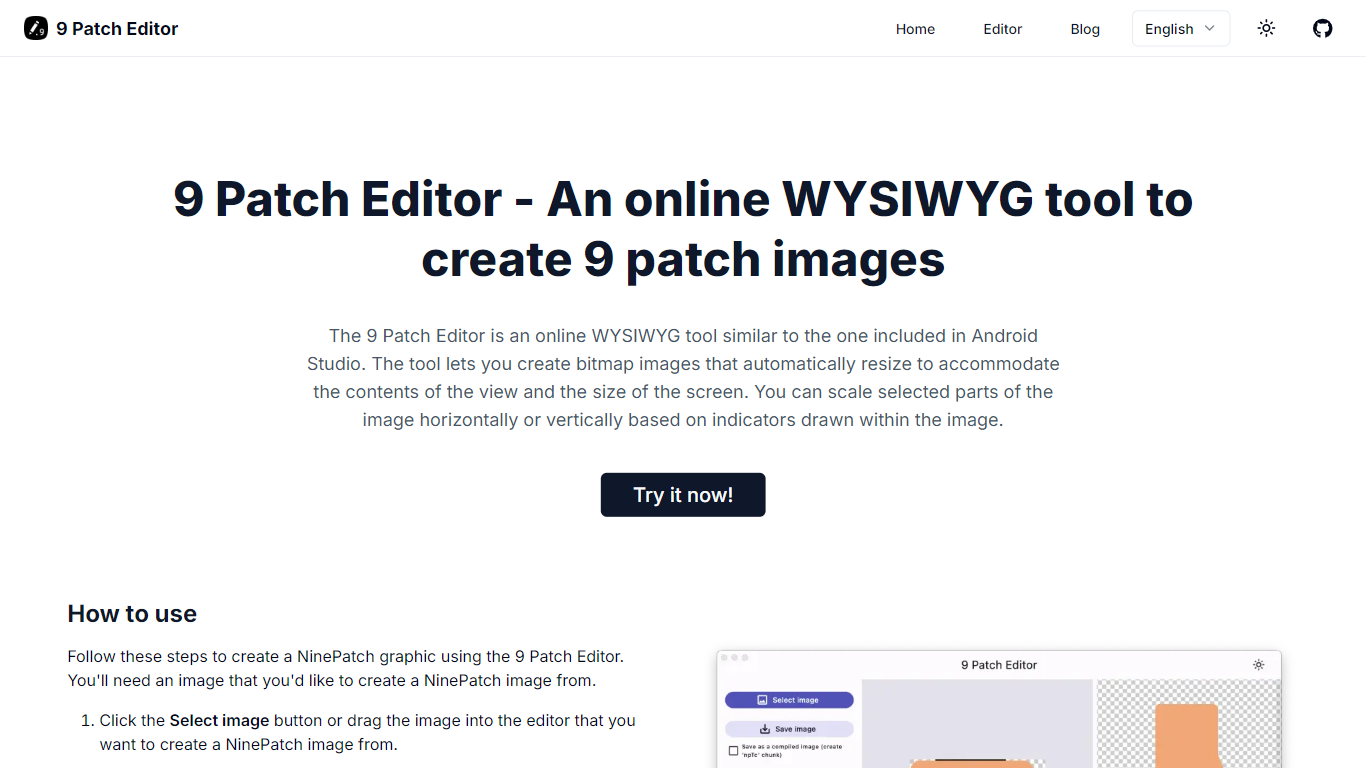
Last updated 10-23-2025
Category:
Reviews:
Join thousands of AI enthusiasts in the World of AI!
9 Patch Editor
The 9 Patch Editor is an online WYSIWYG tool designed to help users create 9 patch images, which are essential for developing flexible user interfaces. This tool allows users to convert bitmap images into stretchable graphics that can automatically resize based on the content and screen size. By using indicators drawn within the image, users can scale specific parts of the image both horizontally and vertically, ensuring that their designs adapt seamlessly to various display conditions.
Targeted primarily at developers and designers, the 9 Patch Editor serves those who need to create adaptable UI elements for applications, particularly in the Android ecosystem. It simplifies the process of creating 9 patch images, which are crucial for ensuring that applications look good on different devices and screen sizes. The tool is user-friendly, making it accessible even for those who may not have extensive technical backgrounds.
One of the unique value propositions of the 9 Patch Editor is its WYSIWYG (What You See Is What You Get) interface, which allows users to see real-time previews of their graphics as they make adjustments. This immediate feedback helps users understand how their changes will affect the final output, making the design process more intuitive and efficient. Additionally, the tool is web-based, meaning users can access it from anywhere without the need for installation.
Key differentiators include its focus on 9 patch image creation specifically, as opposed to general image editing tools. The 9 Patch Editor provides specialized features that cater to the unique requirements of creating stretchable graphics, such as the ability to define stretchable regions and content areas directly within the interface. This targeted functionality sets it apart from more generic graphic design tools.
In terms of technical implementation, the 9 Patch Editor operates entirely online, allowing for easy access and collaboration. Users can upload standard PNG files and create 9 patch images without needing to download any software. The tool also includes helpful guidelines, such as ensuring that stretchable regions are at least 2x2 pixels in size, to prevent issues during scaling. Overall, the 9 Patch Editor is a valuable resource for anyone looking to create responsive and visually appealing user interfaces.
WYSIWYG Interface: Users can see real-time previews of their images as they edit, making it easier to create the desired look without guesswork.
Stretchable Regions: The tool allows users to define specific areas of the image that can stretch, ensuring that the graphics adapt to different screen sizes.
Content Area Definition: Users can specify content areas within the image, which helps in managing how text and other elements are displayed.
Easy Upload: Users can upload standard PNG files to create 9 patch images without needing to install any software.
Guidelines for Scaling: The tool provides helpful tips, such as ensuring stretchable regions are at least 2x2 pixels, to avoid issues during scaling.
What is a 9 patch image?
A 9 patch image is a special type of bitmap image that can stretch to fit different screen sizes while maintaining the design's integrity.
How do I create a 9 patch image?
To create a 9 patch image, upload a bitmap image to the 9 Patch Editor and use the tools to define stretchable regions and content areas.
Can I preview my image while editing?
Yes, the 9 Patch Editor has a preview area where you can see how your image will look as you make changes.
What file types can I upload?
You can upload standard PNG files to create 9 patch images using the editor.
Is there a size requirement for stretchable regions?
Yes, stretchable regions should be at least 2x2 pixels in size to ensure they scale down properly.
Do I need to install any software to use the 9 Patch Editor?
No, the 9 Patch Editor is an online tool, so you can use it directly in your web browser without installation.
What happens if I don't follow the guidelines for scaling?
If you don't follow the guidelines, such as not providing enough space around stretchable regions, it may cause issues like disappearing parts when the image is scaled.
